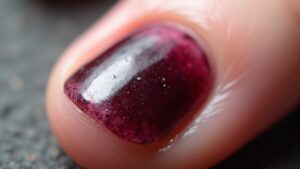A subungual hematoma occurs when blood accumulates beneath the nail, usually after a sudden impact or repetitive pressure. This common injury transforms the nail into a dark red or black shade, frequently leading to throbbing pain and tenderness. While minor cases resolve on their own, severe ones may necessitate draining to alleviate pressure. Understanding the causes—like stubbing a toe or dropping something heavy—aids in preventing future accidents. Identifying symptoms promptly ensures appropriate care, but recognizing when to seek assistance makes all the difference.
What Is a Subungual Hematoma?
A subungual hematoma frequently occurs as something crushes or jams a finger or toe, causing blood to accumulate under the nail. This medical condition takes place when trauma breaks tiny blood vessels beneath the nail, trapping blood underneath the hard surface.
The pressure from the buildup can cause sharp pain, and the skin under the nail might darken to deep red, purple, or black as the hematoma forms. Over time, the discolored area can grow outward as the nail does, though severe cases could require medical attention to relieve discomfort.
While minor injuries often heal on their own, persistent pain or swelling should prompt a visit to a healthcare provider. Comprehension of the causes and symptoms assists in managing the condition effectively.
Common Causes of Subungual Hematoma
Subungual hematomas often result from injuries that damage the blood vessels beneath the nail. Whenever trauma occurs—like dropping something heavy on a finger—the nail bed suffers, causing the blood vessels to break, pooling blood under the nail (the medical term for bleeding is “hematoma”). While some heal naturally over months, severe cases necessitate seeking medical attention.
- Acute Trauma: Slamming a door or stubbing a toe crushes the nail bed, leading to a subungual hematoma.
- Repetitive Pressure: Tight shoes or high-impact sports repeatedly stress the nail, causing bleeding beneath it.
- Improper Footwear: Ill-fitting shoes squeeze toes, increasing the risk of chronic injury—though the nail might grow back.
Understanding these causes helps prevent long-term damage and guarantees timely care when needed.
Symptoms and Signs to Watch For
As blood amasses beneath the nail following an injury, the pressure and discoloration can be challenging to overlook. Pain and tenderness often develop quickly, worsening as blood pools under the nail. The nail might darken, turning shades of red, purple, or black, depending on the severity.
Swelling and redness around the nail fold can accompany the discolored nail, while pressure from trapped blood may cause the nail to lift from the nail bed. In more severe cases, the hematoma covers a large portion of the nail, increasing discomfort. Though uncommon, drainage could be needed if pressure becomes unbearable.
Recognizing these signs promptly helps in managing discomfort and preventing complications, though treatment options should be discussed separately.
Treatment Options for Subungual Hematoma
How can a subungual hematoma—an unsightly, painful buildup of blood under the nail—be treated effectively? Subungual hematomas, usually caused by trauma to the finger or toe, require prompt care to ease discomfort and prevent complications.
Immediate Relief: Apply ice in a cloth to reduce swelling and pain. Over-the-counter pain relievers can help manage discomfort.
Draining the Blood: For severe cases, a procedure called nail trephination might be needed. A small hole is made in the nail plate to drain the blood, relieving pressure.
Monitoring: Seek medical attention if pain continues or signs of infection appear. A doctor can diagnose the severity and determine the need for further treatment.
Early intervention helps prevent long-term damage, allowing the nail to heal naturally over time.
Recovery and Long-Term Outlook
After treating a subungual hematoma, the focus shifts to healing and what to anticipate as the nail recovers. The discoloration of the nail often remains until a new nail replaces the damaged one, which can take months for a subungual hematoma to fully grow out.
Should the injury to the base damage the nail matrix, the nail might grow back with ridges or deformities. Proper care includes keeping the area clean to prevent infection and monitoring for unusual changes over time. Most individuals notice gradual improvement as the nail heals, but severe cases could necessitate follow-up care.
Patience is key, as the process can take 6–9 months. Watching for persistent pain or swelling guarantees complications are addressed promptly.
Conclusion
A subungual hematoma can be painful and unsettling, but most cases heal well with time and care. Some worry that draining the blood will lead to infection, but when executed properly—using sterile tools—the risk is minimal. Maintaining the nail clean and protected assists in preventing complications. In the event that pain endures or the nail grows back strangely, consulting a doctor safeguards against any concealed harm. Perseverance is crucial; nails require months to fully recuperate.


